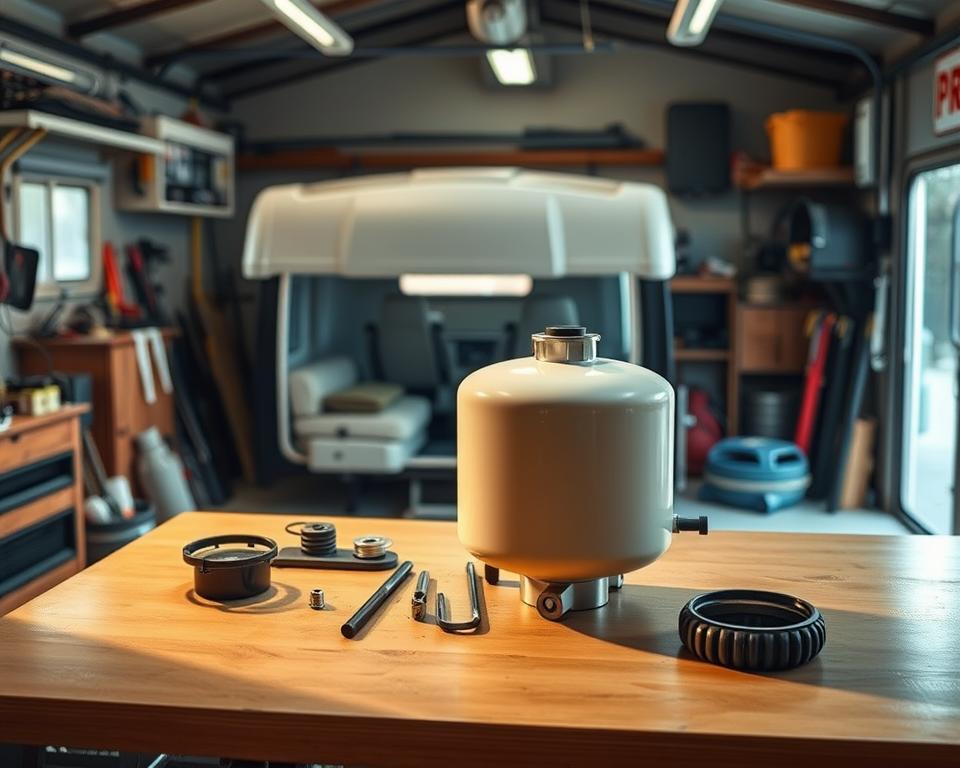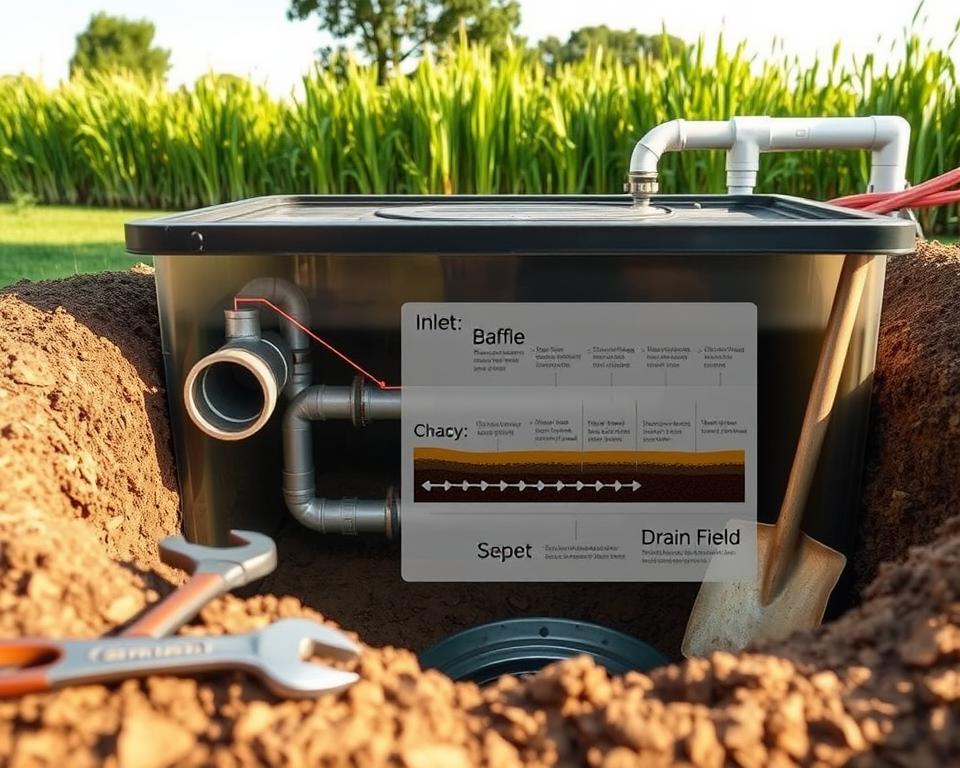Camper Waste Pump Manual: Key Maintenance Advice
Did you ever ponder the functioning of your camper’s waste disposal system? Being aware of the ins and outs of your RV sewer pump can prevent mishaps, enhancing your camping excursions. It’s about controlling waste effectively and dodging noxious odors. Through this guide, you’ll discover vital maintenance strategies for RV septic tank pumping. Each strategy is intended to support your sewage system’s optimal function.
Learning About Your Camper Waste Pump Configuration
The RV sewer pump system is indispensable for waste management, making RV outings more comfortable. It includes two main tanks: the black-water reservoir for solid waste and the grey-water reservoir for water from wash basins and shower stalls. Distinguishing between these tanks is important to prevent clogs and keep your RV functioning efficiently.
An RV waste grinder is a widely used solution for waste management. It pulverizes solid waste into small fragments, streamlining disposal. In contrast, a classic RV pump is available. It competently moves waste without grinding, for those seeking a simpler option.
Knowing your RV’s waste pump setup is crucial to stopping problems and ensuring smooth examinations. Managing the system properly can prevent messes, boosting your outdoor adventures.
Value of Regular Service
Caring for your RV sewage disposal pump is vital for a smooth travel experience. Without proper maintenance, you may face odors, clogs, or backups. These issues can spoil your road trips.
Consistent servicing avoid such issues and lengthen your system’s life. By inspecting hoses and seals, you boost efficiency. A well-serviced RV sewage pump guarantees hygienic operation, letting you enjoy seamless excursions.
Frequent upkeep also brings financial savings over time. Disregard can cause expensive failures, requiring cost-intensive maintenance. Investing in regular maintenance keeps your motorhome in optimal state, preserving money long term.
When to Empty Your RV Septic Tank?
Knowing the right time to pump your RV Septic Tank is essential for its upkeep. It’s recommended to pump every three to five days during use. For weekend journeys, after-journey servicing may work fine.
Interval depends on multiple considerations. Tank size and frequency of use are important. Preferably pump when it reaches two thirds. This helps maintain steady waste movement and stop clogs.
Monitoring your RV Septic tank capacity is key for a stress-free outing. Handle your camper’s sewage to prevent issues while traveling.

Top Techniques for Tank Drainage
Safely purging RV tanks is crucial for your motorhome’s cleanliness and functionality. Start with the black water tank to let the grey water rinse leftover solids. This technique avoids clogs and ensures smooth operation.
Pick a durable drain hose for disposal. A robust hose ward off leaks and locks connections. Attach a tank rinser for a complete flush, using water pressure to remove residual sludge, improving cleanliness.
Thorough draining prevents residue buildup, avoiding foul odors and potential issues. To maintain an well-functioning sewage system in your motorhome, observe these guidelines:
- Regularly use a tank treatment to manage smells and break down waste.
- Keep an eye on fill levels to avoid leaks.
- Check your RV sewer pump often for clogs and wear.
- Deep rinse tanks each month or twice monthly, even during less frequent trips.
Implementing these practices enhances your sewage system’s lifespan and efficiency, ensuring pleasant trips.
Avoiding Foul Odors and Clogs
For a enjoyable trip, keeping odors at bay is crucial. Keep enough water in tanks to aid in decomposition, avoiding unpleasant odors. Also, opting for RV-approved tissue helps prevent clogs, ensuring uninterrupted operation.
For better sewage management in campers, try enzyme-based tank treatments. These effectively break down waste, streamlining care. Check the vent line often to keep air moving freely in the plumbing system.
Cautious flushing is crucial to avoiding tank issues. Refrain from disposing of wipes, feminine products, and paper towels. These non-degradable objects can cause significant obstructions. Following these tips helps maintain a more sanitary camping environment.
Care Recommendations for RV Waste Pumps
Maintaining your RV’s sewer pump system is essential for smooth journeys. Check valve seal integrity often to prevent leaks. Faulty seals can cause surprise messes, harming your RV.
To eradicate odors and maintain cleanliness, sanitizing is key. Carry out intensive cleans quarterly to avoid deposits, ensuring the system functions optimally. These steps are critical for maintaining a portable RV pump, promoting long life and efficient operation.
Oiling valve mechanisms is another essential task. It helps avoid drips and maximize functionality. Monitoring tank sensors is key for accurate readings, preventing overflows and unexpected pump issues. Staying on top of these checks makes your RV adventures neater and more enjoyable.
Indicators You Need Expert Pumping
Recognizing waste troubles promptly can ward off major issues. A tell-tale indicator you need a pro pump service is sluggish flow. When sinks and toilets take longer to clear, it often points to backups. It suggests your system may be full.
Lingering smells are another clear sign of sewage troubles. Stench that won’t go away despite cleaning suggest trapped waste. It’s crucial to check the transparent elbow fitting when dumping waste. Visible residue signals it’s time for professional pump service.
Technicians use high-pressure jets to break up hard obstructions efficiently. Ignoring these warnings can grow into major problems. Therefore, it’s critical to seek help immediately when issues arise.
| Indicators of Sewer Trouble | Possible Action |
|---|---|
| Slow Draining | Inspect for clogs; arrange professional pump-out |
| Ongoing Foul Scents | Check vents; contact pro service |
| Visible Waste Residue | Arrange expert emptying and cleaning |
Selecting the Ideal RV Waste Grinder
When choosing an RV macerator pump, weigh its capacity, durability, and compatibility with your RV’s size. A premium macerator is vital for smooth sludge processing. This is especially important for RVs requiring regular emptying. High-end pumps optimize sewage handling, ensuring a better travel experience.
Multiple designs cater to varied requirements. For an informed decision, focus on these essential considerations:
- Capacity: Ensure the pump can handle your RV’s waste output.
- Durability: Opt for models built to endure travel demands.
- Ease of Use: Select pumps with intuitive controls.
- Compatibility: Ensure it integrates with your system.
Taking time to compare when choosing an RV macerator pump boosts travel enjoyment and ensures proper sewage disposal.
Troubleshooting Your RV Sewer Pump
Accurate diagnosis for your RV sewer pump is key in addressing common sewage issues before they worsen. If you notice lethargic outflow, unexpected backups, or persistent odors, act quickly. These are obvious indicators of malfunction requiring attention.
Begin by examining the pump, its connections, and hoses. Look for any clogs that could slow flow. Ensure inlet and outlet fittings are properly connected. Also, verify the pump’s power supply for stability.
If basic checks don’t uncover the issue, note the pump’s sound. A unit that’s overly noisy or abnormally quiet may have internal damage. Also, check for leaks, as these can worsen sewage problems. With these troubleshooting steps, many RV owners can find and resolve issues early, avoiding costly repairs.
Sustained Maintenance for RV Sewer Pumps
For lasting performance, dedicate yourself to regular sewer pump upkeep. Flush the system consistently to prevent clogs. Set up and observe a maintenance routine, keeping everyone informed of their roles. This significantly extends your waste system’s lifespan.
Training yourself and others on proper waste disposal is key. This avoidss issues and fosters shared responsibility. The result benefits both users and the sewer system.
- Inspect plumbing and hoses periodically
- Flush and clean filters often
- Arrange yearly pro maintenance
- Apply recommended conditioners
Following these guidelines enhances your camper’s sewage system’s durability and keeps it functional, making travels more delightful.
Conclusion
Keeping your RV sewer pump in prime condition is crucial for smooth camping adventures. Regular attention to RV sewer system maintenance markedly cuts problem risks, letting you focus in the journey. By understanding your system and using reliable sewage methods, your trips will be free of waste management woes.
Implementing the key tips from this guide promotes RV waste management and advances your travel comfort and safety. Ensure pump reliability by following best upkeep practices and addressing potential issues promptly.
Staying vigilant about your RV sewer system is rewarding. It provides homely comforts while exploring. Wishing you joyous and relaxed journeys!
FAQ
When should I schedule RV Septic tank emptying?
Pump the RV Septic tank when it hits 66% capacity.
What’s the difference between the black tank and the grey tank?
Black tank is for sewage waste. Meanwhile, the grey tank collects water from basins and showers.
What is the recommended maintenance schedule for RV sewer pumps?
Perform maintenance every few months.
Recommended products for RV sewer pump maintenance?
Opt for biological tank additives.
How do I avoid clogs in my RV sewer system?
Use only RV-safe toilet paper.
How to know if I need expert pump-out?
Blockages, foul scents, or tank overflow warrant expert service.
How can I improve my RV macerator pump’s efficiency?
Choose a robust model and follow manufacturer guidelines.
Deep cleaning checklist for RV sewer system?
Flush lines, replace seals, and sanitize components.
Maintaining my RV sewer system over time?
Adopt regular deep cleans and consistent sanitation.
How often should I empty my RV Septic tank with regular use?
Empty every three to five days.


